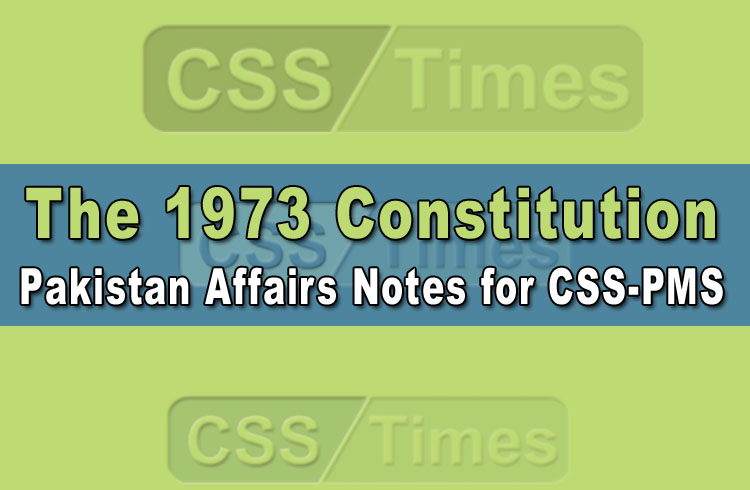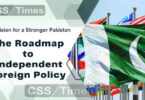The 1973 Constitution | Pakistan Affairs Notes for CSS-PMS
1. Background
2. Constitution Making
3. Features
1. Background
Abrogation of the 1962 Constitution on March 25, 1969 led to second martial law in the country. Yahya Khan handed over power to Zulfikar Ali Bhutto on December 20, 1971 after the first general elections. But martial law continued and there was no constitution.
National Assembly approved an Interim Constitution, which was enforced on April 21, 1972.
2: Constitution Making
Constitutional Committee comprising National Assembly (NA) members from all parties was set up in April 1972. Law Minister was the Chairman of this Committee.
All parties agreed on the future political system in October 1972. The Committee reported on December 31, 1972. After long deliberations and compromises final draft was approved unanimously on April 10, 1973. The new Constitution was enforced on August 14, 1973.
The Constitution functioned since then with two gaps. It remained operational during following periods:
1973-77: Operational
1977-1985: Suspended
1985-1999: Operational after changes
1999-2002 : Suspended
2002 onwards Operational after changes
3: Features of the 1973 Constitution
3.1. Parliamentary System
It was a parliamentary constitution having powerful Prime Minister (PM) as head of government with a very weak President.
Read also: The 1962 Constitution | Pakistan Affairs Notes for CSS-PMS
President must act on the advice of PM. All his orders were to be countersigned by PM. Prime Minister to be elected by the NA.
PM exercised all executive authority. PM was answerable to the NA.
In 1985, powers of the President were increased. He enjoyed some discretion in appointments of PM. He had power to dissolve the NA. He had the powers of appointment of caretaker PM. He gives his assent to bills passed by the parliament or returns these.
3.2. President:
Must be at least 45 years of age, Muslim, qualified to become member of the NA. He is elected by the Parliament and the Provincial Assemblies for 5 years.
3.3. Parliament with two houses:
- Upper House called Senate. In this house equal representation is given to Provinces. Seats are reserved for the tribal areas, women and technocrats. Its original strength was 63, which was later raised to 87 and then 100. Senate is elected indirectly. It’s a permanent House as half of its members are elected after three years.
- Lower House: National Assembly is elected on population basis. Its Original strength was 210 but now it is 342. NA is elected for five years.
- Senate: Indirect elections
- National Assembly: Direct elections
- Voting age for the franchise is lowered from 21 to 18.
- Parliament under 1973 constitution is a powerful legislative body. It enjoys all legislative powers. It has control of the executive through questions, resolutions, parliamentary committees etc.
- National Assembly is more powerful than the Senate. Budget is presented before NA. Cabinet is answerable to National Assembly.
3.4. Federal System
Federation of Pakistan has four provinces and federally administered areas.
Two lists are given in the constitution: Federal list and Concurrent list. Residuary powers belong to provinces.
check also: Check Also: Pakistan Affairs MCQs
3.5. Provincial Structure: 1973 Constitution
Provincial Governors are appointed by the President on the advice of the PM. Elected Chief Minister exercises executive powers. Parliamentary system is there in the provinces. Size of the provincial assemblies varies:
In 2002:
Punjab 371
Sindh 168
NWFP 124
Balochistan 65
Enough provincial autonomy is guaranteed. Tradition of strong centre continues.
Centre has emergency powers. Governor’s rule can be imposed if the government cannot function in the provinces.
Provinces are dependent on centre for Finances.
3.6. Principles of Policy in 1973 Constitution
:
a. Islamic provisions are provided in Principles of Policy. Foreign policy principles are also given under this heading.
3.7. 1973 Constitution – Fundamental Rights:
b. Fundamental Rights are secured in the constitution and are implemented through the highest court.
3.8. 1973 Constitution Islamic Provisions :
c. Title of the state is Islamic Republic of Pakistan.
d. The objectives resolution was the Preamble in the initial constitution but through article 2-A of 8th amendment it was inserted in the constitution in 1985.
e. Islam was declared the State Religion of Pakistan.
f. Definition of Muslim was included by an amendment.
g. Principles of Policy also carry some Islamic clauses.
h. Council for Islamic Ideology is established under the constitution. i. Federal Shariat Court was added in 1981.
3.9. National Language in 1973 Constitution :
j. Urdu is declared National Language, however English may be used for official purposes until arrangements would be made for its replacement by Urdu.
k. Provincial Assembly may prescribe measures for teaching, promotion and use of a provincial language in addition to the national language.
3.10. National Security Council 1973 Constitution
:
l. National Security Council was added in 2002 in advisory capacity.
3.11. Judiciary in 1973 Constitution
:
m. An independent judiciary is given under the constitution. Supreme Court of Pakistan is the highest court. One High Court is established in each province and one in Azad Kashmir. A chain of lower courts is there under the high courts.
Check Other NOTES for Pakistan Affairs
- Unveiling Pakistan’s Nuclear Capabilities
- Allama Iqbal’s Contribution to Islamic Thought and Literature
- The Asian Development Bank’s Investment in Pakistan: A Review
- The Future of Pakistan’s Defence System: Prospects and Challenges
- The Politics of IMF Loans to Pakistan: Debates and Controversies
- A Vision for a Stronger Pakistan: The Roadmap to Independent Foreign Policy
- Reinventing a Nation: Reimagining Pakistan
- Understanding the Role of Caretaker Government in Pakistan’s Democratic Process
- The National Action Plan: An Overview
- Allama Iqbal | The Name — Not The Philosophy — Lives On







